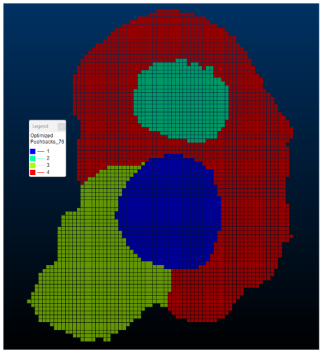Scheduling Setup: Pushbacks
To access this screen:
-
In the Scheduling Setup screen, select the Pushbacks tab.
Define the pushback file to be scheduled and the corresponding bench lags.
Pushbacks can be either be those generated using Studio NPVS+ (see Pushback Generation Essentials) or you can import pushback designs from outside the optimization workflow. You can also change the topography.
The middle of the screen displays the pushback names (which can be edited) and each pushback's minimum tonnage requirement to be considered valid for extraction (essentially, defining the size of an unmineable fragment).
See Scheduling Pushbacks.
Pushback Bench Lags
Typically, Studio NPVS+ determines pushback dependencies automatically on the basis of the position of each pushback in the pushback sequence and pushback locations in the mine. If pushback B is dependent on pushback A, a bench at a given elevation within pushback B cannot be mined until the bench at the same elevation within pushback A has been mined.
The right of the screen lists the bench lags between pushbacks and their corresponding bench lag, if any. So, what is a "bench lag"?
Consider pushback B and pushback A, where benches of pushback B are dependent on those of pushback A, where the dependency takes the form of "you can't start to mine a bench of pushback B if the base of A is significantly higher or lower, by a number of benches".
A "lag" is defined as the difference between bottom bench elevations of pushback B and pushback A must always remain equal to or greater than K benches. The integer K may be negative, zero or positive. In this case, pushback A is the Leader, pushback B is the Follower and K is the bench lag.
Bench lags can either be defined as either:
-
Sequential—Dependencies are created between contiguous or close pushbacks ensuring slope integrity. You can view the Leader and Follower relationship for the existing pushbacks, but you can't edit them.
-
Sequential + Custom—With this option, all sequential dependencies are preserved and new custom dependencies are added. Select this option to attempt to maintain a sequential set of dependencies between pushbacks unless custom instructions, which take precedence, override them.
For example, to set up a 3 bench lag between pushbacks 1 and 2, you could use the following settings (click to expand):
In either case, the Follower should stay at least a minimum number of benches above the Leader, which is set using Min. This is the bench differential K for the mining order. The default value is -1. Setting the minimum value below this can lead to slope violations, whereas if it is equal to or greater than, more restrictive dependencies generally occur.
Bench lag constraints may not be satisfied in the first time period of a schedule. A lag constraint for a given pushback is ignored once that pushback has been completely mined; for example, once pushback 1 has been completely mined, pushback 2 can go deeper than allowed by the bench lag.
In summary, bench lags can be used to set how mining a pushback relates to mining the remaining pushbacks. Sequential is defining the geometric constraints that exist between the pushbacks and the table is populated automatically.
Bench Lag Example
In the example below pushback 2 does not depend on pushback 1 and pushback 3 does not depend on pushback 2. Pushback 3 depends only on pushback 1 and pushback 4 depends on 1, 2, and 3.
(Click the images for a clearer view)
To define pushbacks for scheduling:
-
Define scheduler periods.
-
Display the Pushbacks screen.
-
Choose where pushback data is coming from:
-
Choose Use Default Pushbacks & Topo to use pushback data generated from the optimization workflow tools. In this case, the Schedule will use the pushbacks created by Studio NPVS+.
-
Choose Use Other Pushbacks or Topo to use imported designs.
-
Choose the Initial Topography from the list. All project surfaces are listed.
-
If using anything other than the default topography, pick a Pit Code that represents the topography (you can only select a surface number within a range valid for the selected data.
Note: Selecting the correct Pit Code is important when the initial topography file contains multiple surfaces.
-
-
-
Review the Pushback table in the middle of the screen; if you need to, edit the Name of any pushback (updating all other references automatically).
-
For each pushback, if appropriate, decide the Min to Mine (the minimum amount required for the pushback to qualify as mineable).
In other words, define the minimum mass to be mined from a pushback when mining this pushback starts or resumes. The value is set in Mt.
-
Define the Bench Lags for the pushbacks, either using Sequential or Sequential + Custom rules.
See "Pushback Bench Lags", above.
-
Save your scheduler settings.
Related topics and activities




